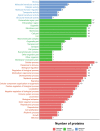Profiling the Bisecting N-acetylglucosamine Modification in Amniotic Membrane via Mass Spectrometry
- PMID: 35123071
- PMCID: PMC9880894
- DOI: 10.1016/j.gpb.2021.09.010
Profiling the Bisecting N-acetylglucosamine Modification in Amniotic Membrane via Mass Spectrometry
Abstract
Bisecting N-acetylglucosamine (GlcNAc), a GlcNAc linked to the core β-mannose residue via a β1,4 linkage, is a special type of N-glycosylation that has been reported to be involved in various biological processes, such as cell adhesion and fetal development. This N-glycan structure is abundant in human trophoblasts, which is postulated to be resistant to natural killer cell-mediated cytotoxicity, enabling a mother to nourish a fetus without rejection. In this study, we hypothesized that the human amniotic membrane, which serves as the last barrier for the fetus, may also express bisected-type glycans. To test this hypothesis, glycomic analysis of the human amniotic membrane was performed, and bisected N-glycans were detected. Furthermore, our proteomic data, which have been previously employed to explore human missing proteins, were analyzed and the presence of bisecting GlcNAc-modified peptides was confirmed. A total of 41 glycoproteins with 43 glycopeptides were found to possess a bisecting GlcNAc, and 25 of these glycoproteins were reported to exhibit this type of modification for the first time. These results provide insights into the potential roles of bisecting GlcNAc modification in the human amniotic membrane, and can be beneficial to functional studies on glycoproteins with bisecting GlcNAc modifications and functional studies on immune suppression in human placenta.
Keywords: Amniotic membrane; Bisecting N-acetylglucosamine; Glycan; Glycoprotein; Mass spectrometry.
Copyright © 2022 The Authors. Published by Elsevier B.V. All rights reserved.
Figures







Similar articles
-
The Essential Functions and Detection of Bisecting GlcNAc in Cell Biology.Front Chem. 2020 Jul 3;8:511. doi: 10.3389/fchem.2020.00511. eCollection 2020. Front Chem. 2020. PMID: 32719771 Free PMC article. Review.
-
Bisecting GlcNAc restricts conformations of branches in model N-glycans with GlcNAc termini.Carbohydr Res. 2018 Feb 1;456:53-60. doi: 10.1016/j.carres.2017.12.002. Epub 2017 Dec 14. Carbohydr Res. 2018. PMID: 29274553
-
Bisecting GlcNAc Is a General Suppressor of Terminal Modification of N-glycan.Mol Cell Proteomics. 2019 Oct;18(10):2044-2057. doi: 10.1074/mcp.RA119.001534. Epub 2019 Aug 2. Mol Cell Proteomics. 2019. PMID: 31375533 Free PMC article.
-
Bisecting N-Acetylglucosamine of the N-Glycan of Immunoglobulin G Does Not Affect Binding to Fc Gamma Receptors.ACS Chem Biol. 2025 Mar 21;20(3):680-689. doi: 10.1021/acschembio.4c00807. Epub 2025 Feb 19. ACS Chem Biol. 2025. PMID: 39970331 Free PMC article.
-
Functional roles of the bisecting GlcNAc in integrin-mediated cell adhesion.Methods Enzymol. 2010;480:445-59. doi: 10.1016/S0076-6879(10)80019-9. Methods Enzymol. 2010. PMID: 20816221 Review.
Cited by
-
Non-targeted isomer-sensitive N-glycome analysis reveals new layers of organ-specific diversity in mice.Res Sq [Preprint]. 2024 Apr 9:rs.3.rs-4130712. doi: 10.21203/rs.3.rs-4130712/v1. Res Sq. 2024. Update in: Nat Commun. 2024 Nov 9;15(1):9725. doi: 10.1038/s41467-024-54134-z. PMID: 38659835 Free PMC article. Updated. Preprint.
-
Analysis of carbohydrates and glycoconjugates by matrix-assisted laser desorption/ionization mass spectrometry: An update for 2021-2022.Mass Spectrom Rev. 2025 May-Jun;44(3):213-453. doi: 10.1002/mas.21873. Epub 2024 Jun 24. Mass Spectrom Rev. 2025. PMID: 38925550 Free PMC article. Review.
-
One-carbon metabolites supplementation and nutrient restriction alter the fetal liver metabolomic profile during early gestation in beef heifers.J Anim Sci. 2024 Jan 3;102:skae258. doi: 10.1093/jas/skae258. J Anim Sci. 2024. PMID: 39234988
-
Non-targeted N-glycome profiling reveals multiple layers of organ-specific diversity in mice.Nat Commun. 2024 Nov 9;15(1):9725. doi: 10.1038/s41467-024-54134-z. Nat Commun. 2024. PMID: 39521793 Free PMC article.
-
Systematic synthesis of bisected N-glycans and unique recognitions by glycan-binding proteins.Chem Sci. 2022 Jun 9;13(25):7644-7656. doi: 10.1039/d1sc05435j. eCollection 2022 Jun 29. Chem Sci. 2022. PMID: 35872821 Free PMC article.
References
-
- Kizuka Y., Taniguchi N. Neural functions of bisecting GlcNAc. Glycoconj J. 2018;35:345–351. - PubMed
-
- Schachter H. Complex N-glycans: the story of the “yellow brick road”. Glycoconj J. 2014;31:1–5. - PubMed
-
- Harpaz N., Schachter H. Control of glycoprotein synthesis. Processing of asparagine-linked oligosaccharides by one or more rat liver Golgi alpha-D-mannosidases dependent on the prior action of UDP-N-acetylglucosamine: alpha-D-mannoside beta 2-N-acetylglucosaminyltransferase I. J Biol Chem. 1980;255:4894–4902. - PubMed
-
- Yamashita K., Tachibana Y., Kobata A. The structures of the galactose-containing sugar chains of ovalbumin. J Biol Chem. 1978;253:3862–3869. - PubMed
MeSH terms
Substances
LinkOut - more resources
Full Text Sources

